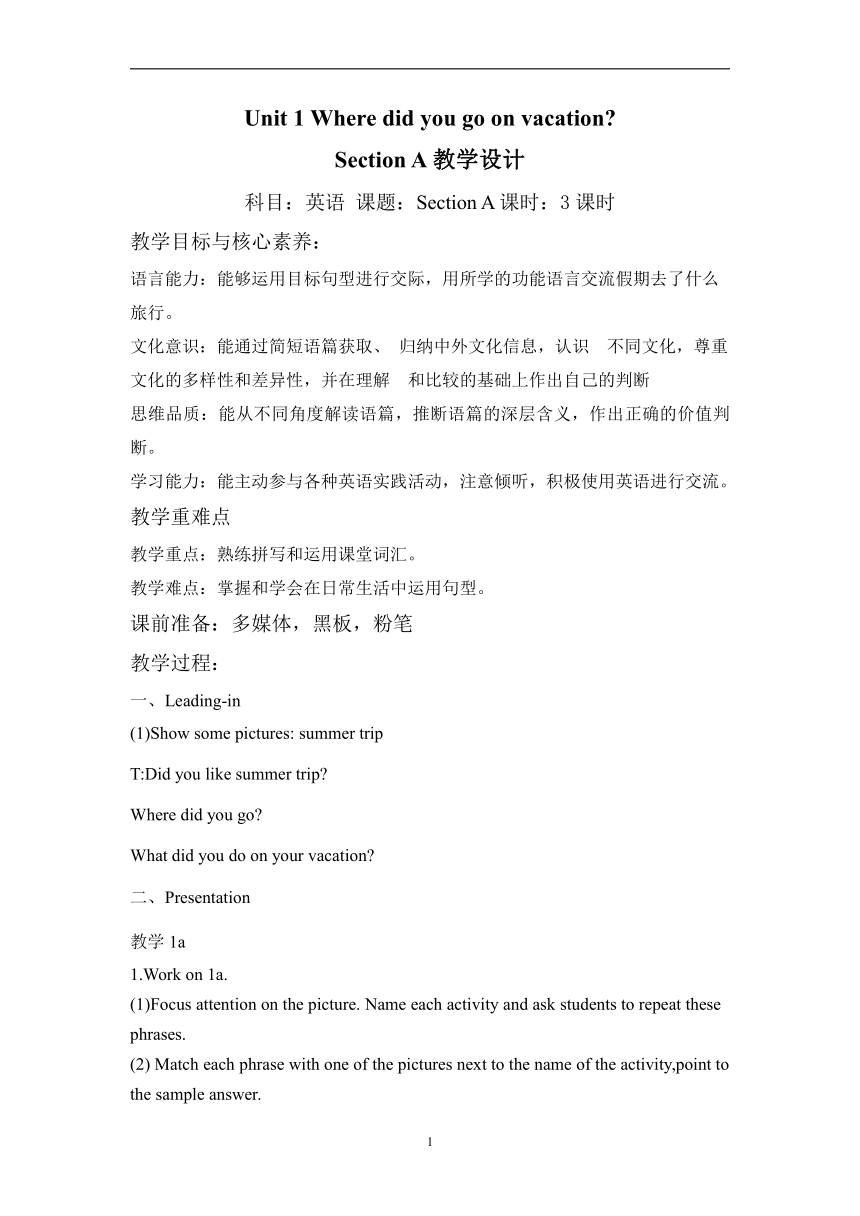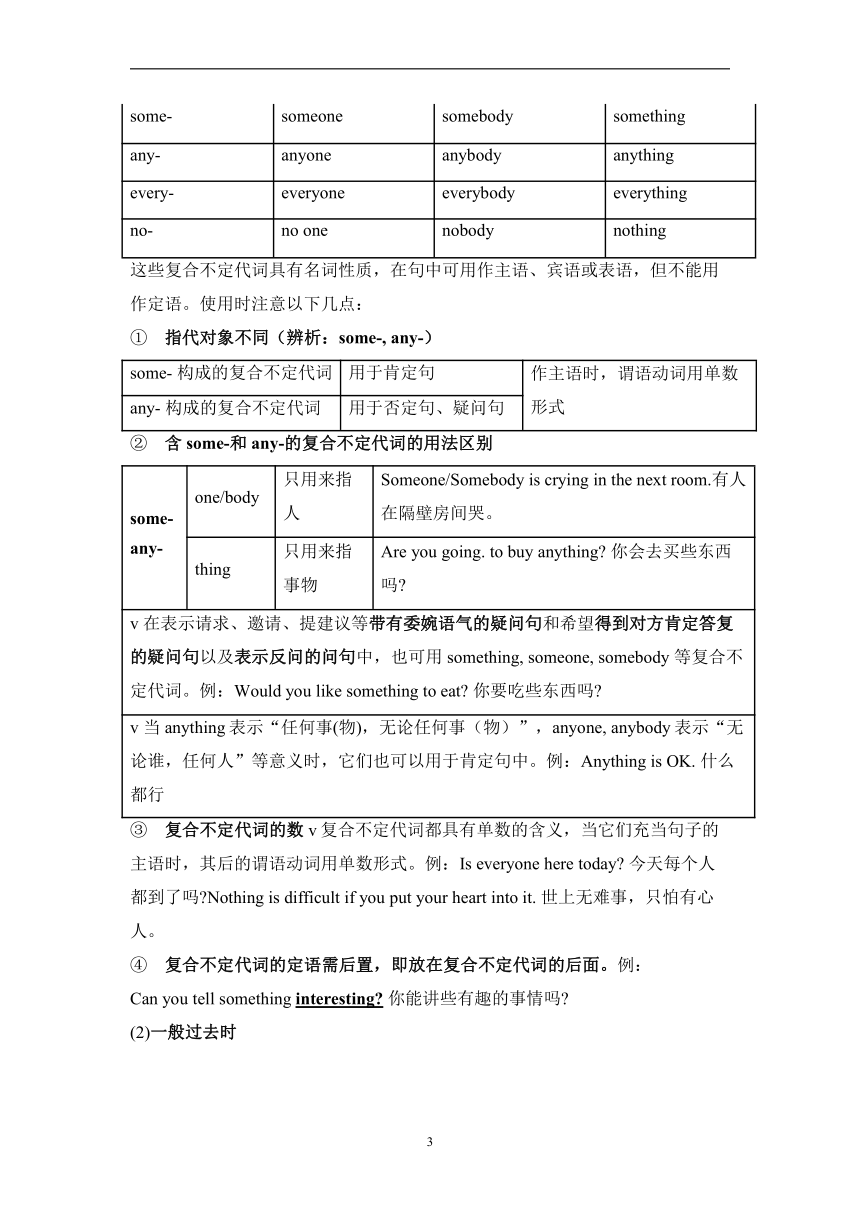Unit 1 Where did you go on vacation Section A 教案
文档属性
| 名称 | Unit 1 Where did you go on vacation Section A 教案 |  | |
| 格式 | docx | ||
| 文件大小 | 28.7KB | ||
| 资源类型 | 教案 | ||
| 版本资源 | 人教新目标(Go for it)版 | ||
| 科目 | 英语 | ||
| 更新时间 | 2023-10-27 22:37:51 | ||
图片预览



文档简介
Unit 1 Where did you go on vacation
Section A教学设计
科目:英语 课题:Section A 课时:3课时
教学目标与核心素养:
语言能力:能够运用目标句型进行交际,用所学的功能语言交流假期去了什么旅行。
文化意识:能通过简短语篇获取、 归纳中外文化信息,认识 不同文化,尊重文化的多样性和差异性,并在理解 和比较的基础上作出自己的判断
思维品质:能从不同角度解读语篇,推断语篇的深层含义,作出正确的价值判断。
学习能力:能主动参与各种英语实践活动,注意倾听,积极使用英语进行交流。教学重难点
教学重点:熟练拼写和运用课堂词汇。
教学难点:掌握和学会在日常生活中运用句型。
课前准备:多媒体,黑板,粉笔
教学过程:
一、Leading-in
(1)Show some pictures: summer trip
T:Did you like summer trip
Where did you go
What did you do on your vacation
二、Presentation
教学1a
1.Work on 1a.
(1)Focus attention on the picture. Name each activity and ask students to repeat these phrases.
(2) Match each phrase with one of the pictures next to the name of the activity,point to the sample answer.
(3) Check the answers.
教学1b
Listen to the recording and write numbers of the names in the right boxes of the picture. Then check the answers. Next, listen this material again, then fill in blank.
教学1c
l.The teacher explains the instructions to the students
2.The students practice reading the conversation in 1c.
3.Make their own conversations according to the activities in 1a and show them in class.
-Where did Sam go on vacation -He stayed at home.
教学2a
l. Ask the students to read the names in the chart, Tell the students they will hear three conversations about three people's vacations. Match the people with the activities correctly.
2. Play the tape the first time, and ask the students to listen only
3. Replay the tape and let the students try to fill in the blanks.
4. Check the answers.
教学2b
l.Let students look at the chart and read the names and the
activities in the chart.
2.Play the tape the first time,and let students only listen.
3.Play the tape again.Let students try to fill in the blanks
4.Check the answers.
角色扮演Role-play the conversation.
1.The teacher explains the instructions to the students. Students read the example in the speech bubble.
2.Work in groups to role-play the conversation. Students can talk about the activities from the chart in 2b or other activities
三、Language Points
(1)复合不定代词不指明代替任何特定名词的代词叫作不定代词。复合不定代词是由some-, any-, every-, no- 加上-one, -body, -thing等所组成的不定代词。
-one -body -thing
some- someone somebody something
any- anyone anybody anything
every- everyone everybody everything
no- no one nobody nothing
这些复合不定代词具有名词性质,在句中可用作主语、宾语或表语,但不能用作定语。使用时注意以下几点:
① 指代对象不同(辨析:some-, any-)
some- 构成的复合不定代词 用于肯定句 作主语时,谓语动词用单数形式
any- 构成的复合不定代词 用于否定句、疑问句
② 含some-和any-的复合不定代词的用法区别
some-any- one/body 只用来指人 Someone/Somebody is crying in the next room.有人在隔壁房间哭。
thing 只用来指事物 Are you going. to buy anything 你会去买些东西吗
v 在表示请求、邀请、提建议等带有委婉语气的疑问句和希望得到对方肯定答复的疑问句以及表示反问的问句中,也可用something, someone, somebody 等复合不定代词。例:Would you like something to eat 你要吃些东西吗
v 当anything表示“任何事(物),无论任何事(物)”,anyone, anybody表示“无论谁,任何人”等意义时,它们也可以用于肯定句中。例:Anything is OK. 什么都行
③ 复合不定代词的数v复合不定代词都具有单数的含义,当它们充当句子的主语时,其后的谓语动词用单数形式。例:Is everyone here today 今天每个人都到了吗 Nothing is difficult if you put your heart into it. 世上无难事,只怕有心人。
④ 复合不定代词的定语需后置,即放在复合不定代词的后面。例:Can you tell something interesting 你能讲些有趣的事情吗
(2)一般过去时
① 一般过去时的用法一般过去时用来描述过去发生的动作或存在的状态。常和一般过去时搭配的标志性的时间状语有yesterday, last week, in the past等。例:They stayed at home yesterday. 昨天他们待在家里。
② 一般过去时的三种句式结构:
含be动词 主语+was/ were+表语 They were very happy. 他们很开心。
There be句型 There was/ were+主语+地点状语 There was a farm near here two years ago.两年前这儿附近有一个农场。
含行为动词 主语+行为动词的过去式+其他 The students went to the farm yesterday.昨天学生们去农场了。
③ 一般过去时的句式变化be动词的一般过去时的句式变化
肯定句 主语+was/were+表语 We were at home yesterday. 昨天我们在家。
否定句 主语+wasn’t/weren’t+表语 We weren’t at home yesterday. 昨天我们不在家。
一般疑问句 Was/Were+主语+表语? Were you at home yesterday 昨天你们在家吗
肯定答语 Yes,主语+was/were. —Yes, we were. 是的,我们在家。
否定答语 No,主语+ wasn’t/ weren’t. —No, we weren’t. 不,我们不在家。
there be句型的一般过去时的句式变化:
肯定句 There was/ were+主语+地点状语. There were some trees in the village five years ago.五年前这个村庄有一些树。
否定句 There wasn’t/ weren’t+主语+地点状语. There weren’t any trees in the village five years ago.五年前这个村庄没有树。
一般疑问句 Was/Were there+主语+地点状语 Were there any trees in the village five years ago 五年前这个村庄有树吗
肯定答语 Yes, there was/were. —Yes, there were. 是的,有。
否定答语 No, there wasn’t/ weren’t. —No, there weren't. 不,没有。
行为动词的一般过去时的句式变化
肯定句 主语+动词的过去式+其他. We went to the museum last week. 上周我们去博物馆了。
否定句 主语+didn't+动词原形+其他. We didn’t go to the museum last week. 上周我们没有去博物馆。
一般疑问句 Did+主语+动词原形+其他 Did you go to the museum last week 上周你们去博物馆了吗
肯定答语 Yes, 主语+did. —Yes, we did. 是的,我们去了。
否定答语 No, 主语+didn't. —No, we didn’t. 不,我们没有去。
④ 动词的过去式的变化规律包括规则变化和不规则变化两种。v规则变化通常以-ed结尾。具体如下:
构成规则 举例
一般情况下动词原形末尾加-ed help—helped
结尾是e的动词加-d Live—lived
以重读闭音节结尾,且末尾只有一个辅音字母的动词,先双写这个辅音字母,再加-ed stop—stoppedplan—planned
结尾是“辅音字母+y”的动词,先变y为i再加-ed carry—carried;study—studied
四、Homework
1. 熟练掌握和运用单词。
2. 练习对话,记忆所学的语言结构
2
Section A教学设计
科目:英语 课题:Section A 课时:3课时
教学目标与核心素养:
语言能力:能够运用目标句型进行交际,用所学的功能语言交流假期去了什么旅行。
文化意识:能通过简短语篇获取、 归纳中外文化信息,认识 不同文化,尊重文化的多样性和差异性,并在理解 和比较的基础上作出自己的判断
思维品质:能从不同角度解读语篇,推断语篇的深层含义,作出正确的价值判断。
学习能力:能主动参与各种英语实践活动,注意倾听,积极使用英语进行交流。教学重难点
教学重点:熟练拼写和运用课堂词汇。
教学难点:掌握和学会在日常生活中运用句型。
课前准备:多媒体,黑板,粉笔
教学过程:
一、Leading-in
(1)Show some pictures: summer trip
T:Did you like summer trip
Where did you go
What did you do on your vacation
二、Presentation
教学1a
1.Work on 1a.
(1)Focus attention on the picture. Name each activity and ask students to repeat these phrases.
(2) Match each phrase with one of the pictures next to the name of the activity,point to the sample answer.
(3) Check the answers.
教学1b
Listen to the recording and write numbers of the names in the right boxes of the picture. Then check the answers. Next, listen this material again, then fill in blank.
教学1c
l.The teacher explains the instructions to the students
2.The students practice reading the conversation in 1c.
3.Make their own conversations according to the activities in 1a and show them in class.
-Where did Sam go on vacation -He stayed at home.
教学2a
l. Ask the students to read the names in the chart, Tell the students they will hear three conversations about three people's vacations. Match the people with the activities correctly.
2. Play the tape the first time, and ask the students to listen only
3. Replay the tape and let the students try to fill in the blanks.
4. Check the answers.
教学2b
l.Let students look at the chart and read the names and the
activities in the chart.
2.Play the tape the first time,and let students only listen.
3.Play the tape again.Let students try to fill in the blanks
4.Check the answers.
角色扮演Role-play the conversation.
1.The teacher explains the instructions to the students. Students read the example in the speech bubble.
2.Work in groups to role-play the conversation. Students can talk about the activities from the chart in 2b or other activities
三、Language Points
(1)复合不定代词不指明代替任何特定名词的代词叫作不定代词。复合不定代词是由some-, any-, every-, no- 加上-one, -body, -thing等所组成的不定代词。
-one -body -thing
some- someone somebody something
any- anyone anybody anything
every- everyone everybody everything
no- no one nobody nothing
这些复合不定代词具有名词性质,在句中可用作主语、宾语或表语,但不能用作定语。使用时注意以下几点:
① 指代对象不同(辨析:some-, any-)
some- 构成的复合不定代词 用于肯定句 作主语时,谓语动词用单数形式
any- 构成的复合不定代词 用于否定句、疑问句
② 含some-和any-的复合不定代词的用法区别
some-any- one/body 只用来指人 Someone/Somebody is crying in the next room.有人在隔壁房间哭。
thing 只用来指事物 Are you going. to buy anything 你会去买些东西吗
v 在表示请求、邀请、提建议等带有委婉语气的疑问句和希望得到对方肯定答复的疑问句以及表示反问的问句中,也可用something, someone, somebody 等复合不定代词。例:Would you like something to eat 你要吃些东西吗
v 当anything表示“任何事(物),无论任何事(物)”,anyone, anybody表示“无论谁,任何人”等意义时,它们也可以用于肯定句中。例:Anything is OK. 什么都行
③ 复合不定代词的数v复合不定代词都具有单数的含义,当它们充当句子的主语时,其后的谓语动词用单数形式。例:Is everyone here today 今天每个人都到了吗 Nothing is difficult if you put your heart into it. 世上无难事,只怕有心人。
④ 复合不定代词的定语需后置,即放在复合不定代词的后面。例:Can you tell something interesting 你能讲些有趣的事情吗
(2)一般过去时
① 一般过去时的用法一般过去时用来描述过去发生的动作或存在的状态。常和一般过去时搭配的标志性的时间状语有yesterday, last week, in the past等。例:They stayed at home yesterday. 昨天他们待在家里。
② 一般过去时的三种句式结构:
含be动词 主语+was/ were+表语 They were very happy. 他们很开心。
There be句型 There was/ were+主语+地点状语 There was a farm near here two years ago.两年前这儿附近有一个农场。
含行为动词 主语+行为动词的过去式+其他 The students went to the farm yesterday.昨天学生们去农场了。
③ 一般过去时的句式变化be动词的一般过去时的句式变化
肯定句 主语+was/were+表语 We were at home yesterday. 昨天我们在家。
否定句 主语+wasn’t/weren’t+表语 We weren’t at home yesterday. 昨天我们不在家。
一般疑问句 Was/Were+主语+表语? Were you at home yesterday 昨天你们在家吗
肯定答语 Yes,主语+was/were. —Yes, we were. 是的,我们在家。
否定答语 No,主语+ wasn’t/ weren’t. —No, we weren’t. 不,我们不在家。
there be句型的一般过去时的句式变化:
肯定句 There was/ were+主语+地点状语. There were some trees in the village five years ago.五年前这个村庄有一些树。
否定句 There wasn’t/ weren’t+主语+地点状语. There weren’t any trees in the village five years ago.五年前这个村庄没有树。
一般疑问句 Was/Were there+主语+地点状语 Were there any trees in the village five years ago 五年前这个村庄有树吗
肯定答语 Yes, there was/were. —Yes, there were. 是的,有。
否定答语 No, there wasn’t/ weren’t. —No, there weren't. 不,没有。
行为动词的一般过去时的句式变化
肯定句 主语+动词的过去式+其他. We went to the museum last week. 上周我们去博物馆了。
否定句 主语+didn't+动词原形+其他. We didn’t go to the museum last week. 上周我们没有去博物馆。
一般疑问句 Did+主语+动词原形+其他 Did you go to the museum last week 上周你们去博物馆了吗
肯定答语 Yes, 主语+did. —Yes, we did. 是的,我们去了。
否定答语 No, 主语+didn't. —No, we didn’t. 不,我们没有去。
④ 动词的过去式的变化规律包括规则变化和不规则变化两种。v规则变化通常以-ed结尾。具体如下:
构成规则 举例
一般情况下动词原形末尾加-ed help—helped
结尾是e的动词加-d Live—lived
以重读闭音节结尾,且末尾只有一个辅音字母的动词,先双写这个辅音字母,再加-ed stop—stoppedplan—planned
结尾是“辅音字母+y”的动词,先变y为i再加-ed carry—carried;study—studied
四、Homework
1. 熟练掌握和运用单词。
2. 练习对话,记忆所学的语言结构
2
同课章节目录
- Unit 1 Where did you go on vacation?
- Section A
- Section B
- Unit 2 How often do you exercise?
- Section A
- Section B
- Unit 3 I'm more outgoing than my sister.
- Section A
- Section B
- Unit 4 What's the best movie theater?
- Section A
- Section B
- Unit 5 Do you want to watch a game show?
- Section A
- Section B
- Unit 6 I'm going to study computer science.
- Section A
- Section B
- Unit 7 Will people have robots?
- Section A
- Section B
- Unit 8 How do you make a banana milk shake?
- Section A
- Section B
- Unit 9 Can you come to my party?
- Section A
- Section B
- Unit 10 If you go to the party, you'll have a grea
- Section A
- Section B
